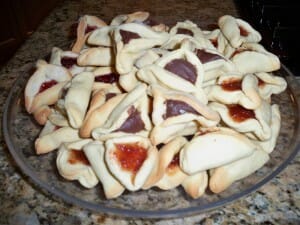
Traditional Food for Purim
As a child, I grew up unaware of the Jewish holiday of Purim. I was raised by two Jewish parents who chose not to celebrate or participate in any of the customs associated with the holiday. My Jewish friends and acquaintances did not mention it either. When I was 4 years old, I celebrated Purim at my Jewish preschool. I have to admit that I have vague recollections of that entire year. Sadly, I did not become aware of the holiday until after I met my husband while I was attending the University of Colorado.
I was not alone. Many Jews and Gentiles are unfamiliar with Purim. I encourage parents to share one of the five Purim picture books reviewed below. Learning about different traditions is essential to living in a culturally diverse world. This year Purim begins on Saturday evening, March 15.
Why do Jews Celebrate Purim?
Jews celebrate Purim to remember what happened in the Persian Empire during the 4th century BCE. The ruler of this extensive empire was King Ahasureus. The king executed his wife, Queen Vashti, because she failed to follow his orders. He used a beauty pageant as a means to find a new wife. Esther, a Jewish woman, was chosen to be his new queen.
Haman, the king’s prime minister wanted everyone to bow down to him. When Mordecai, Esther’s cousin, refused to comply, Haman became outraged. He convinced the king to issue an anti-Semitic decree that called for the extermination of all Jews in the kingdom.
Esther bravely approached the king and revealed her Jewish identity. Haman was hanged and Mordecai became the new prime minister. Under Mordecai’s leadership the Jews were free to defend themselves.
Purim comes from the Hebrew word pur. Pur means “lot,” which refers to the lots that Haman cast to determine the date for the destruction of the Jews.
The Story of Esther is found in the third section, Ketuvim (Writings), in the Jewish Bible. It is also in the Old Testament.
How is Purim Celebrated?
Synagogue:
Shabbat (Sabbath) Services. The Torah section called Zachor (remember) is chanted on the Saturday before Purim. The reading recalls the negative actions of Amalek (one of Haman’s ancestors). He also tried to annihilate the Jews.
Listen to the reading of the Megillah (Scroll of Esther). It is read once on Purim Eve and a second time on Purim day. It is considered a mitzvah to listen to the entire Megillah. During the reading, Haman’s name is mentioned numerous times. It is customary for congregants to twirl a gragger (noisemaker) to blot out this evil man’s name.
Attend a Purim carnival or play. Many synagogues and Jewish institutions entertain their younger congregants by hosting a carnival. Children play games and win prizes. Oftentimes food is served.
Wearing Costumes. Children wear costumes to the Megillah reading and sometimes they also continue the masquerade during the carnival.
Home:
Food & Beverages- Observant Jews indulge in a special meal on Purim day. Jews traditionally drink wine or other alcoholic beverages while celebrating this festive day. Hamentaschen, a triangular shaped cookie (like Haman’s hat) with a filling in the middle. Traditional fillings are prune and poppy seed. Our family’s favorite are strawberry and chocolate.
Fast of Esther. Modern observant Jews fast on the day before Purim. In so doing, they are recalling the Jews who fasted and prayed while waiting for King Ahasuerus’ decree.
Community:
Contributing to the Needy (Matanot La’Evyonim). Jews make a conscious effort to help the less fortunate throughout the year. Some Jewish organizations make a special appeal during Purim.
Mishloach Manot. Another tradition is to send small packages of food to friends and relatives. Synagogues oftentimes organize the delivery service.
5 Purim Picture Books
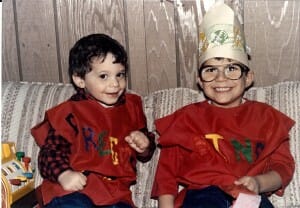
Purim Costumes
1985
I was determined that our 4 children would observe the holiday. Our family celebrated this joyous occasion at home and in the synagogue. Our third son was born right before Purim. His bar mitzvah coincided with the Torah reading Zachor.
Today, children can learn about Purim by reading colorful and engaging picture books.
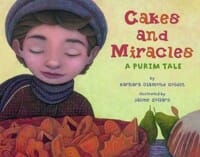 Cakes and Miracles: A Purim Tale. By Barbara Diamond Goldin and illustrated by Jaime Zollars. (Marshall Cavendish Corporation, 2010) originally published with a longer text by Viking Press in 1991.
Cakes and Miracles: A Purim Tale. By Barbara Diamond Goldin and illustrated by Jaime Zollars. (Marshall Cavendish Corporation, 2010) originally published with a longer text by Viking Press in 1991.
This tale focuses on Hershel, a blind boy who lives with his widowed mother. He spends many days by the river constructing different objects in the mud. He loves what he is able to create. His mother feels that his disability limits his overall abilities. During Purim, Hershel demonstrates that he is capable despite his limitations. This uplifting story provides information about the celebration of Purim, shtetl life, and how the human spirit can overcome diversity.
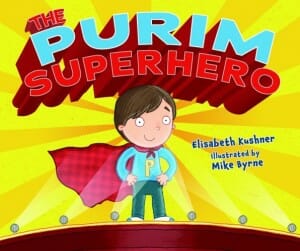 The Purim Superhero. Elisabeth Kushner illustrated by Mike Byrne (Kar-Ben Publishing, 2013)
The Purim Superhero. Elisabeth Kushner illustrated by Mike Byrne (Kar-Ben Publishing, 2013)
In a powerful way, this story capitalizes on one of the main concepts of Purim- tolerance and acceptance of diversity. The story begins when Nate and his classmates are discussing the costumes that they will wear for Purim. Nate’s friends want to be super heroes while Nate would prefer to be an alien. Nate, like most children, would like to fit in and not be different from his friends. During a conversation with one of his fathers, he hears an important message. “Sometimes showing who you really are makes you stronger, even if you’re different from other people.” Nate also realizes that he is not like most other kids who have a mom and a dad. He has two fathers. Children reading this book will understand Nate’s dilemma and appreciate the decision that he makes.
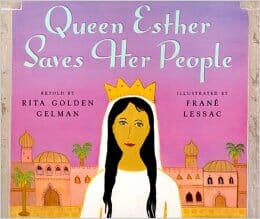 Queen Esther Saves Her People. Retold by Rita Goldin Gelman and illustrated by Frane’ Lessac (Scholastic, 1998)
Queen Esther Saves Her People. Retold by Rita Goldin Gelman and illustrated by Frane’ Lessac (Scholastic, 1998)
Notable children’s author Rita Goldin Gelman retells the biblical Story of Esther in an age appropriate way while Frane’ professionally illustrates life in ancient Persia. The format is perfect for a read aloud. One side of the page has a short printed text enhanced with a border and the other side has a colorful picture created using gouache. The words and the illustrations take the reader back to ancient life in the Persian Empire. Additional information about Purim is included in A Purim Notebook at the end of the book. This is an older publication that may be more difficult to find. If you cannot purchase this book, I highly recommend trying to find it at your local library.
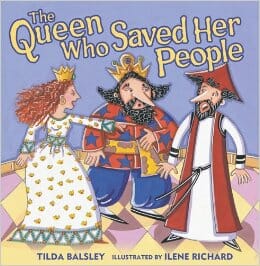 The Queen Who Saved Her People. By Tilda Balseley and illustrated by Ilene Richard (Kar-Ben, 2011) Using the format of a Purim shpiel (comic dramatization or play), Tlida provides an overview of the biblical story of Esther. The short rhythmic verses flow smoothly while maintaining a comic edge. The text is color coded so that it can be used as a reader’s theater script. The black, green, purple, blue, and red fonts correspond to the narrator, King Ahashuerus, Queen Esther, Mordechai and Haman. This color-coding will also make it easier for an adult to change intonations when reading aloud to children. Some of the dialogue is set off in bubbles and the rest is just part of the text. Ilene’s vibrant illustrations add to the understanding of the printed text.
The Queen Who Saved Her People. By Tilda Balseley and illustrated by Ilene Richard (Kar-Ben, 2011) Using the format of a Purim shpiel (comic dramatization or play), Tlida provides an overview of the biblical story of Esther. The short rhythmic verses flow smoothly while maintaining a comic edge. The text is color coded so that it can be used as a reader’s theater script. The black, green, purple, blue, and red fonts correspond to the narrator, King Ahashuerus, Queen Esther, Mordechai and Haman. This color-coding will also make it easier for an adult to change intonations when reading aloud to children. Some of the dialogue is set off in bubbles and the rest is just part of the text. Ilene’s vibrant illustrations add to the understanding of the printed text.
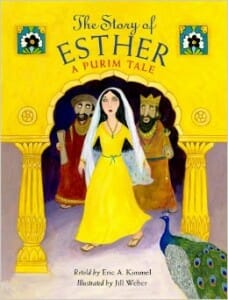 The Story of Esther: A Purim Tale. Retold by Eric A Kimmel and illustrated by Jill Weber. Holiday House, 2011. Master story teller Eric A Kimmel puts his magic touch on the biblical Story of Esther. His lengthy text is more suited for upper elementary students than younger children. Eric skillfully highlights important facts and details from the original version into a child friendly adaptation. Jill’s creative artwork includes a mixture of acrylic, gouache, tempera, watercolor inks and pencil. The detailed drawings adds to the overall appeal and provides a better understanding of life in ancient Persia.
The Story of Esther: A Purim Tale. Retold by Eric A Kimmel and illustrated by Jill Weber. Holiday House, 2011. Master story teller Eric A Kimmel puts his magic touch on the biblical Story of Esther. His lengthy text is more suited for upper elementary students than younger children. Eric skillfully highlights important facts and details from the original version into a child friendly adaptation. Jill’s creative artwork includes a mixture of acrylic, gouache, tempera, watercolor inks and pencil. The detailed drawings adds to the overall appeal and provides a better understanding of life in ancient Persia.
Related Blogs:
8 Gifts for 8 Nights: Jewish Children’s Holiday Books
Memorable Holocaust Picture Books
Picture Books for the High Holidays
Purim and Freshly Baked Hamentaschen
Bio
Sandra Bornstein is the author of MAY THIS BE THE BEST YEAR OF YOUR LIFE. It is available on Amazon.
Sandra’s memoir highlights her living and teaching adventure in Bangalore, India. She is a licensed Colorado teacher who has taught K-12 students in the United States and abroad as well as college level courses. Sandra is married and has four adult sons.
The memoir was a finalist in the Travel category for the 2013 Next Generation Indie Book Awards, the 2013 International Book Awards, the 2013 National Indie Book Excellence Awards, 2013 USA Best Book Awards, and a Honorable Mention award in the Multicultural Non-Fiction category for the 2013 Global ebook Awards.
Leave a Reply
You must be logged in to post a comment.